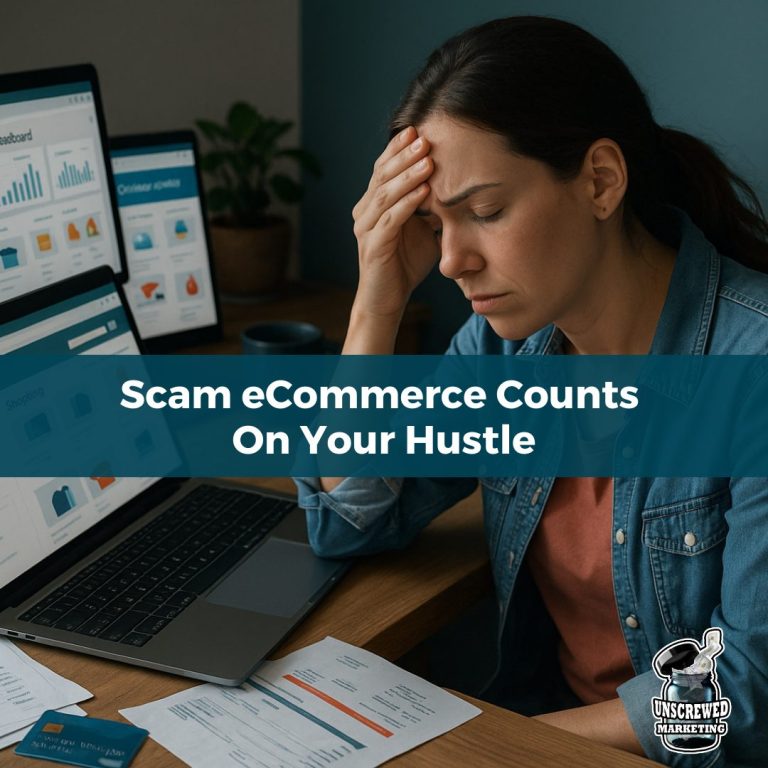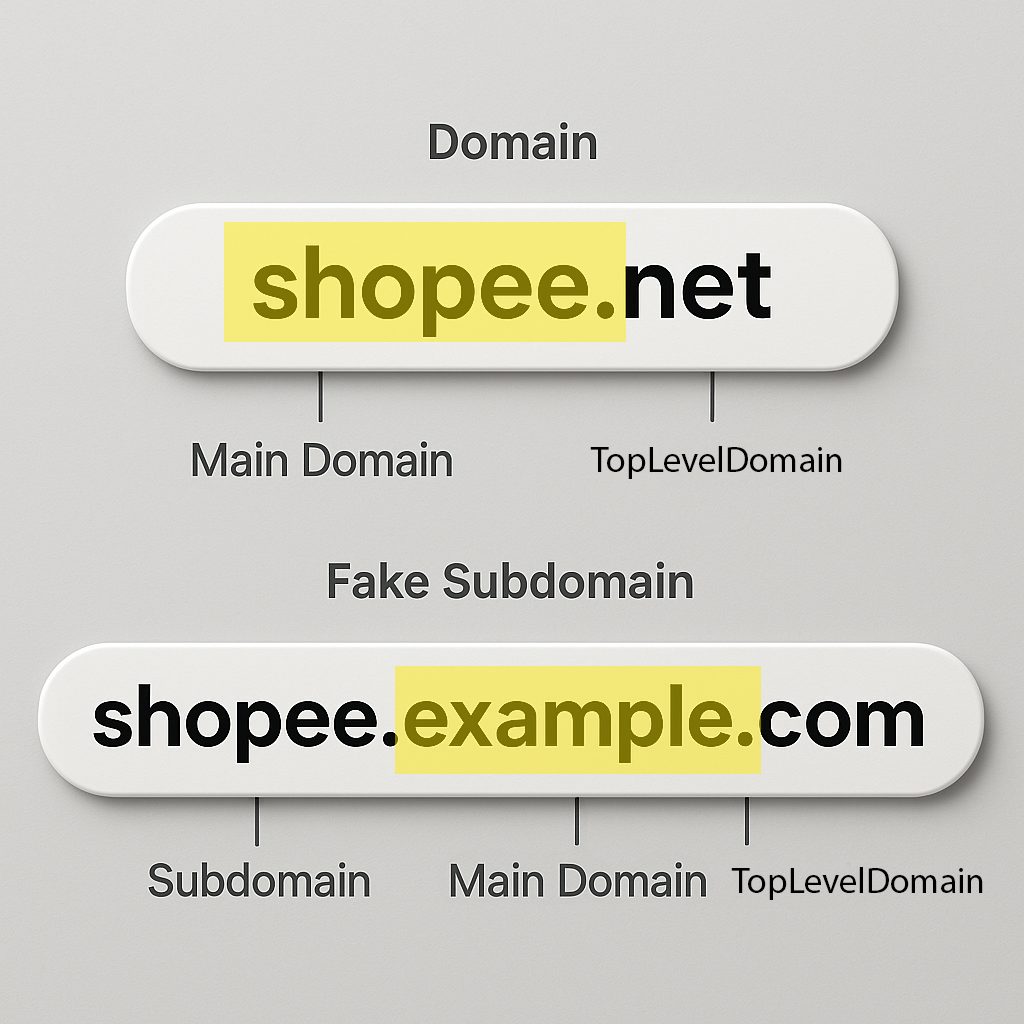- +1 512-591-8295
- [email protected]
- Mon - Fri: 9:00 - 16:00
- +1 512-591-8295
- [email protected]
- Mon - Fri: 9:00 - 16:00
Use code MOM50 at checkout thru Mother’s Day to get 50% off any gift card for marketing services

Becoming an entrepreneur is one of the most exciting things you can do! And eCommerce often seems like a relatively easy way to do so. Entrepreneurs are rushing into e-commerce faster than ever; lured by promises of easy profits, “done-for-you” platforms, and quick online shops. But behind many of these “opportunities” is something far darker: scams designed to drain your bank account, your savings, and even your sanity.
We see it people talking about it every day, entrepreneurs are sharing stories of being duped by what looked like legitimate e-commerce setups, only to realize they weren’t running a business at all—they were fueling a scam.
Let’s break down the most common types showing up right now.
This is the most common trap. Many budding entrepreneurs think they join a site such as Shopee as a merchant. They join a site that looks official, but looking at the URL that they joined tells the real story: shopee.lkz563.com.
Here’s the problem: scammers register domains that look almost identical to the real thing. Most entrepreneurs don’t notice the extra string of letters or the “.madeup.com” tag, they’re too busy trying to set up shop and get sales.
By the time they realize their “store” isn’t on the real Shopee (or Lazada, or Amazon, or whatever else), their money is already gone.
Red flag: Always verify the actual domain. shopee.com is not the same thing as shopee.lkz563.com.
Here’s the downlow: A domain is the website name right next to what we call the “top level domain”. The top level domain is the last tag like .com or .net or .co at the very end of the URL. The domain is the full website name right before that top level domain .com or .net (which I’m going to show as .tld below).
As example, Shopee’s website is shopee.com
When you stick a subdomain on the front, it becomes an entirely different website. That’s different databases behind the website, completely different files, etc. So the pattern becomes subdomain.domain.tld
Here’s the kicker … putting shopee as the subdomain (first), attached to some other random domain, will NEVER be the same thing. That main domain (right there attached to the TLD) is the important piece.

Another entrepreneur bought a model car kit through what they thought was a normal eCommerce listing. It was a very rare model they had been searching for years, and they found it finally for a price that they thought too good to be true. It never shipped. They couldn’t figure out the scam angle; after all, the seller couldn’t get paid unless delivery was confirmed.
Here’s the truth: sometimes the scam isn’t about the product at all. Fake sellers use these “orders” to collect your name, address, and payment data. The product is just bait. What they really want is information they can monetize in other schemes. Such as selling your information on the black market to people who will then use the information to drain your bank account.
Red flag: If the deal looks unbelievably cheap, assume that the product isn’t the point.
A different group of victims found themselves in a twisted combination of e-commerce and crypto.
The scam tells you that you’ll earn profits if you deposit money to ‘process orders.’ But all of the orders are fake. You’re just putting more and more of your own money into the scam, and when you try to withdraw, the tap shuts off.
This scam uses regular money but also crypto – and crypto is easier for the bad guys because once you hand it over, you can’t ever track it again.
At first glance, it sounds ridiculous: why would anyone deposit their own money to “process” orders? But here’s how scammers make it feel believable:
By the time reality sets in—that the customers, the orders, and the profits never existed—the scammer has milked thousands. Entrepreneurs aren’t greedy; they’re being manipulated with systems that look just like the real platforms they’ve heard about.
Red flag: Real platforms don’t ask you to deposit funds to make “returns.”
This is the cruelest one: the eCommerce Closure Nightmare.
Victims believed they were running a real shop. They saw dashboards, customer orders, shipping confirmations. They even borrowed money to “cover shipping fees” while waiting for their account balance to refill.
But there were never customers. Never products. The “orders” were just fake numbers on a screen, designed to convince you to keep paying fees to “unlock” the next stage.
When one entrepreneur tried to close their store, the scammers introduced a new twist: a 25% deposit fee to release settlement funds. They were already $20,000 in debt before realizing it had all been fabricated.
Red flag: If you don’t physically have products or ship them yourself (or through a legitimate verified supplier), you’re not running a store, you’re staring at a scam dashboard.
These scams work because they prey on ambition and overwhelm. Entrepreneurs want growth, freedom, and fast results. Scammers know this—and they create platforms that look polished, complete with bots replying to messages, “policies” that sound official, and fake dashboards that mimic real sales data.
It’s not stupidity. It’s manipulation. And once you’re emotionally invested—and sometimes financially trapped with loans—the sunk cost fallacy kicks in. You keep paying, hoping to claw your way back.
Real e-commerce doesn’t require secret deposits, “unlock” fees, or mystery URLs. Legitimate platforms like WooCommerce, Shopify, or Amazon Seller Central, and even the real Shopee:
When I work with clients, we make sure their systems are transparent, scalable, and under their control. The goal isn’t a quick cash grab; it’s building something sustainable that grows with you, not against you.
Every week you spend chasing bad advice—or falling into one of these scams—is money, time, and credibility you can’t get back.
If you’re not sure whether the opportunity in front of you is real, don’t gamble. Get clarity first.
Because losing money to a scam hurts. But building your business on the wrong foundation? That can cost you everything.
Aren’t sure what you’ve gotten yourself into? Reach out and I’m happy to help you figure it out.
This website uses cookies to ensure you get the best experience on our website. By continuing to use the website, you agree to our use of cookies. We do not share or sell your information. More info